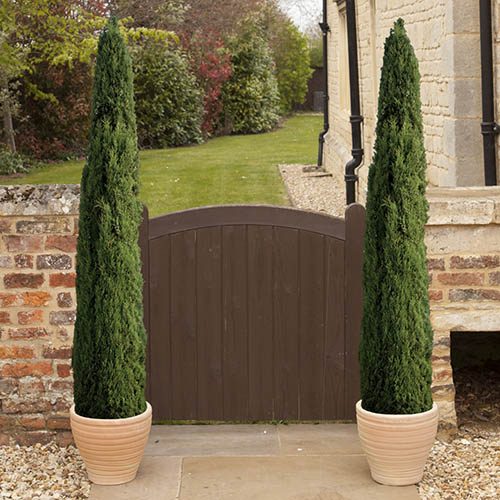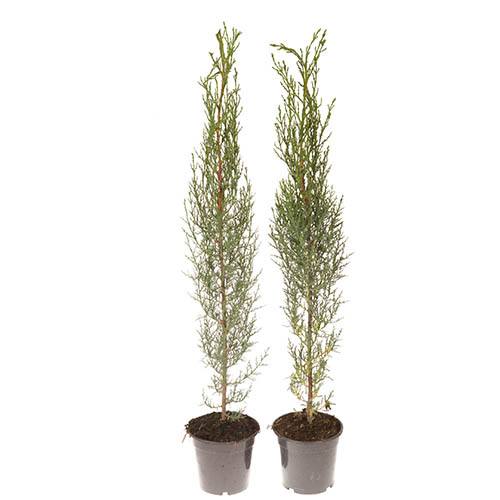Description

Italian Cypress Trees, or Cupressus Sempervirens, are known for their tall, slender growth and vibrant green foliage. These trees are a popular choice for adding a Mediterranean touch to any landscape. Their unique look and easy care make them an excellent choice for both novice and experienced gardeners. This post will provide helpful tips and insights on how to best care for these beautiful trees, ensuring they thrive in your garden. From planting to routine maintenance, learn how to make your Italian Cypress Trees flourish.
Italian Cypress Trees: An Exquisite Evergreen Charm
Overview of Italian Cypress Trees
Italian Cypress Trees, scientifically known as Cupressus sempervirens, are an enchanting species of evergreen trees that have captivated hearts for centuries. With their slender, tall stature and elegant, dark green foliage, these trees exude a timeless beauty that is hard to resist. In this section, we will delve into the description, natural habitat, and historical significance of Italian Cypress Trees, uncovering the fascinating aspects that make them truly remarkable.
Description of Italian Cypress Trees
Italian Cypress Trees are characterized by their distinctive columnar shape, reaching heights of up to 80 feet. Their narrow, erect branches create a slim silhouette that adds a touch of sophistication to any landscape. The leaves of these trees are scale-like and arranged in flattened sprays, giving them a delicate and feathery appearance. The vibrant green color of the foliage remains unchanged throughout the year, providing a constant source of visual delight.
Natural Habitat of Italian Cypress Trees
Originally native to the eastern Mediterranean region, Italian Cypress Trees have found their natural habitat in countries such as Italy, Greece, Turkey, and Cyprus. Thriving in regions with a Mediterranean climate, they are well-adapted to hot, dry summers and mild, wet winters. These trees prefer well-drained soil and require ample sunlight to flourish, making them a perfect fit for coastal areas and regions with similar climatic conditions.
Historical Significance of Italian Cypress Trees
Italian Cypress Trees have an intriguing historical significance that spans across various cultures and epochs. In ancient times, these majestic trees were revered by the Romans and Greeks as symbols of longevity, immortality, and divine protection. They were also associated with mourning and used to mark sacred places, such as burial sites and temples. Their enduring presence in art, literature, and architecture further testifies to their cultural importance throughout history.
From the enchanting landscapes of Tuscany to the revered gardens of ancient civilizations, Italian Cypress Trees have left an indelible mark on human civilization. As we continue to appreciate their timeless beauty, let us pause and marvel at the wonders they behold. In the following sections, we will explore their cultivation, care tips, and the myriad of benefits they bring to our lives. Stay tuned for more insights on these captivating evergreens.
Please note that this article is for informational purposes only and should not be considered as professional gardening advice.
Characteristics of Italian Cypress Trees
Italian Cypress trees, scientifically known as Cupressus sempervirens, are elegant and distinctive trees that add a touch of Mediterranean charm to any landscape. With their tall, slender shape and rich green foliage, they are a popular choice for adding vertical interest and creating privacy screens. In this section, we will explore the key characteristics of Italian Cypress trees, including their size and shape, foliage and bark, as well as their lifespan and growth rate.
Size and Shape of Italian Cypress Trees
Italian Cypress trees are known for their tall and slender shape, which adds a sense of sophistication to any garden or landscape. These trees can reach impressive heights, typically ranging from 40 to 60 feet (12 to 18 meters) at maturity, with some exceptional specimens even growing taller. The vertical growth pattern of Italian Cypress trees gives them a distinctive pencil-like shape, making them ideal for creating formal hedges or lining pathways.
Foliage and Bark of Italian Cypress Trees
The foliage of Italian Cypress trees is evergreen and consists of small, scale-like leaves that tightly cover the branches. The leaves are a vibrant, dark green color, providing a striking contrast against the blue sky or surrounding landscape. Their dense foliage creates a sense of privacy and acts as an effective windbreak, making them an excellent choice for coastal areas.
The bark of Italian Cypress trees is smooth and greyish-brown, with an attractive texture that adds visual interest to the tree’s overall appearance. The combination of the rich green foliage and the elegant bark makes Italian Cypress trees a visually appealing addition to any garden or landscape design.
Lifespan and Growth Rate of Italian Cypress Trees
Italian Cypress trees have a relatively long lifespan, often living for several decades or even centuries when properly cared for. With their slow to moderate growth rate, these trees develop a strong and sturdy structure over time. It’s worth noting that the growth rate may vary depending on the growing conditions, such as soil quality and climate.
When it comes to cultivation, Italian Cypress trees prefer full sun exposure and well-drained soil. They are relatively drought-tolerant once established, making them suitable for regions with hot and dry climates. However, they can also adapt well to other climate zones, including temperate and Mediterranean regions.
Italian Cypress trees are an excellent choice for those seeking a low-maintenance tree that adds elegance and vertical interest to their landscape. With their slender shape, lush green foliage, and attractive bark, these trees bring a touch of the Mediterranean to gardens and landscapes, creating a sense of timeless beauty.
Stay tuned for the next sections of our article, where we will dive deeper into the care and maintenance of Italian Cypress trees, as well as explore creative uses for these magnificent trees in various landscaping projects.
Cultivation and Care of Italian Cypress Trees
Italian Cypress Trees, scientifically known as Cupressus sempervirens, are tall, slender evergreen trees that add a touch of elegance to any landscape. These majestic trees are native to the Mediterranean region and are popular for their striking appearance and versatility. In this section, we will explore the cultivation and care of Italian Cypress Trees, covering ideal growing conditions, planting and propagation, as well as pruning and maintenance techniques.
Ideal Growing Conditions for Italian Cypress Trees
Italian Cypress Trees thrive in warm climates and are well-suited for regions with a Mediterranean climate. They prefer full sun exposure, so it’s essential to choose a location that receives at least 6 to 8 hours of direct sunlight each day. These trees are not fussy about soil type and can adapt to a wide range of conditions, including poor or alkaline soil. However, they do require well-draining soil to prevent root rot.
To promote healthy growth, it’s crucial to provide Italian Cypress Trees with adequate water. While they are drought-tolerant once established, young trees require regular watering. Water deeply, allowing the soil to dry out slightly between waterings. It’s important to strike a balance between providing sufficient moisture and avoiding waterlogged soil.
Planting and Propagation of Italian Cypress Trees
When it comes to planting Italian Cypress Trees, proper spacing is key. These trees can reach heights of up to 60 feet and have a narrow, columnar growth habit. Allow at least 10 to 15 feet between each tree to ensure they have enough room to grow and spread their branches. Before planting, prepare the soil by loosening it and removing any weeds or grass.
To plant Italian Cypress Trees, dig a hole that is as deep as the root ball and twice as wide. Gently remove the tree from its container and place it in the hole, ensuring that the top of the root ball is level with the surrounding soil. Backfill the hole with soil, firming it gently around the roots. Water thoroughly to settle the soil and eliminate any air pockets.
Propagation of Italian Cypress Trees can be done through both seeds and cuttings. However, it’s worth noting that growing from seeds can be a lengthy process, with germination taking several months. If you prefer a quicker method, taking semi-hardwood cuttings in late summer or early autumn is a more reliable option.
Pruning and Maintenance of Italian Cypress Trees
Pruning Italian Cypress Trees is necessary to maintain their desired shape and prevent them from becoming overgrown or top-heavy. The best time to prune is in late winter or early spring before new growth appears. Start by removing any dead, damaged, or diseased branches. Use sharp, clean pruning shears to make clean cuts, angled away from the trunk.
To maintain the characteristic slender and upright shape of Italian Cypress Trees, trim the side branches sparingly. Avoid cutting into the woody trunk as this can lead to unsightly bare patches. Instead, focus on removing any lower branches that are interfering with the tree’s form. Regular light pruning will help keep the tree looking neat and well-maintained.
In terms of maintenance, Italian Cypress Trees are generally low-maintenance once established. However, it’s important to monitor for pests and diseases such as cypress canker and aphids. Regularly inspect the trees for any signs of infestation or damage, and take appropriate measures to control and prevent further issues.
In conclusion, cultivating and caring for Italian Cypress Trees requires attention to ideal growing conditions, proper planting and propagation techniques, as well as regular pruning and maintenance. By providing these majestic trees with the right care, you can enjoy their beauty and elegance in your landscape for years to come.
Uses of Italian Cypress Trees
Italian Cypress Trees, scientifically known as Cupressus Sempervirens, have been cherished and utilized for various purposes throughout history. Their elegant and slender form, combined with their enduring nature, has made them sought after for ornamental, symbolic, cultural, and practical uses. In this blog post section, we will explore the different ways in which Italian Cypress Trees are used.
Ornamental Uses of Italian Cypress Trees
Italian Cypress Trees are renowned for their aesthetic appeal and have long been used as ornamental plants. Their tall, columnar shape adds a sense of grandeur and sophistication to any landscape. These statuesque trees are often planted in rows or clusters to create striking focal points, provide privacy screens, or delineate boundaries. Whether gracing a formal garden or enhancing the entrance of a stately home, Italian Cypress Trees bring a touch of timeless elegance to any setting.
Symbolism and Cultural Significance of Italian Cypress Trees
Italian Cypress Trees hold significant symbolism and cultural importance in various regions. In Mediterranean cultures, these trees are associated with longevity, immortality, and remembrance. They are commonly found in cemeteries and are planted as living memorials to honor the departed. The upward-reaching branches of Italian Cypress Trees symbolize the connection between the earthly and spiritual realms, offering solace and a sense of continuity.
Moreover, Italian Cypress Trees have been embraced as an emblem of resilience and strength. Their ability to thrive in harsh conditions, including drought and poor soil, has led them to be seen as symbols of endurance and determination. These trees have become an integral part of the cultural identity of many regions and continue to inspire awe and admiration.
Practical Uses of Italian Cypress Trees
Apart from their ornamental and symbolic value, Italian Cypress Trees offer practical benefits as well. Their dense foliage provides shelter and privacy, making them ideal for creating windbreaks or shielding outdoor spaces from prying eyes. Additionally, their narrow form allows them to be planted in tight spaces, such as along driveways, walkways, or property borders, where space may be limited.
Furthermore, Italian Cypress Trees are known for their ability to absorb pollutants and improve air quality. By removing harmful substances from the atmosphere, they contribute to creating a healthier and more pleasant environment.
In terms of practical applications, the wood of Italian Cypress Trees is highly valued for its durability and resistance to decay. It is commonly used in the construction of furniture, cabinets, and decorative items. The timber’s fine grain and natural luster make it a desirable material for various woodworking projects.
Italian Cypress Trees truly exemplify the perfect blend of beauty, symbolism, and practicality. Whether adorning landscapes, carrying cultural significance, providing privacy, or supplying valuable timber, these majestic trees continue to captivate and serve a multitude of purposes.
Conclusion
Italian Cypress Trees, scientifically known as Cupressus Sempervirens, are a truly remarkable addition to any garden or landscape. These elegant trees possess numerous beneficial qualities that make them a popular choice among homeowners and landscapers alike.
First and foremost, Italian Cypress Trees are highly valued for their iconic slender and columnar shape. With their tall and narrow growth habit, they can provide an excellent sense of verticality and add a touch of elegance to any outdoor space. This distinctive shape also makes them an ideal choice for narrow or limited spaces, such as along driveways or boundary lines.
Aside from their aesthetic appeal, Italian Cypress Trees also offer practical benefits. They are known for their ability to act as a natural windbreak, providing shelter and protection for other plants and structures in your garden. Additionally, these trees are evergreen, meaning they maintain their lush green foliage throughout the year, even in colder climates. This quality ensures that your garden remains vibrant and appealing, even during the winter months.
Moreover, Italian Cypress Trees are relatively low-maintenance, making them an ideal choice for busy homeowners or those with limited gardening experience. They are drought-tolerant and can thrive in various soil types, as long as they are well-drained. With proper care and occasional pruning to maintain their shape, these trees can last for several decades, providing long-lasting beauty and value to your outdoor space.
Italian Cypress Trees are a fantastic addition to any garden or landscape. Their slender and elegant form, practical benefits, and low-maintenance nature make them a top choice for both aesthetic and practical purposes. So, if you’re looking to enhance the beauty and functionality of your outdoor space, consider adding Italian Cypress Trees to your landscape.




B A BARKER –
Very well packed. Nice sturdy upright plants.
SGS –
My little trees arrived, extremely well-packed on the day after order. They are young and sturdy and exactly as expected. I purchased a pair of these last year, bred by same company and although I was somewhat concerned that they were a bit sparse, can confirm that they have grown on really well over the past few months, both filling out and growing considerably in height. I I transferred them, initially, to larger pots, trimmed them to achieve identical height and shape and added ericaceous fertilizer to the compost. then I just left them, with weekly watering for a few months, during which time they filled out well. In the autumn, I transferred them to open ground, where they are continuing to grow. I would say that they are about1ft taller and 6 inches wider, than when purchased and look very healthy. Because they have done so well. I decided to purchase the smaller size this time and these are very sturdy, so I anticipate a good rate of growth over the coming months. One point to bear in mind is that they do need to be well supported. For some reason, this time I received only 1 stake per 2 plants! It is worth using decent canes and ties to achieve a nice straight growth and resistance to wind. I am delighted with my purchase (6 pairs) and feel that the price of approx. £17.00 per pair represents a great bargain.Highly recommended.
Caroline Poumous-Targett –
Quick to deliver, strong healthy beautiful trees, would highly recommend, thank u
Susie –
Have had theses before good for hiding things you don’t want to see tall and thin not wide also gives hight in my garden really good buy
Susan L. –
I bought 2 of these, one is certainly a Cyprus but the other doesn’t appear to be.
Debra Lloyd –
Quick delivery, well packaged
gary tindall (verified owner) –
Small and spindly I planted them out and you can just about see then from 5 metres
You can buy a lot better elsewhere